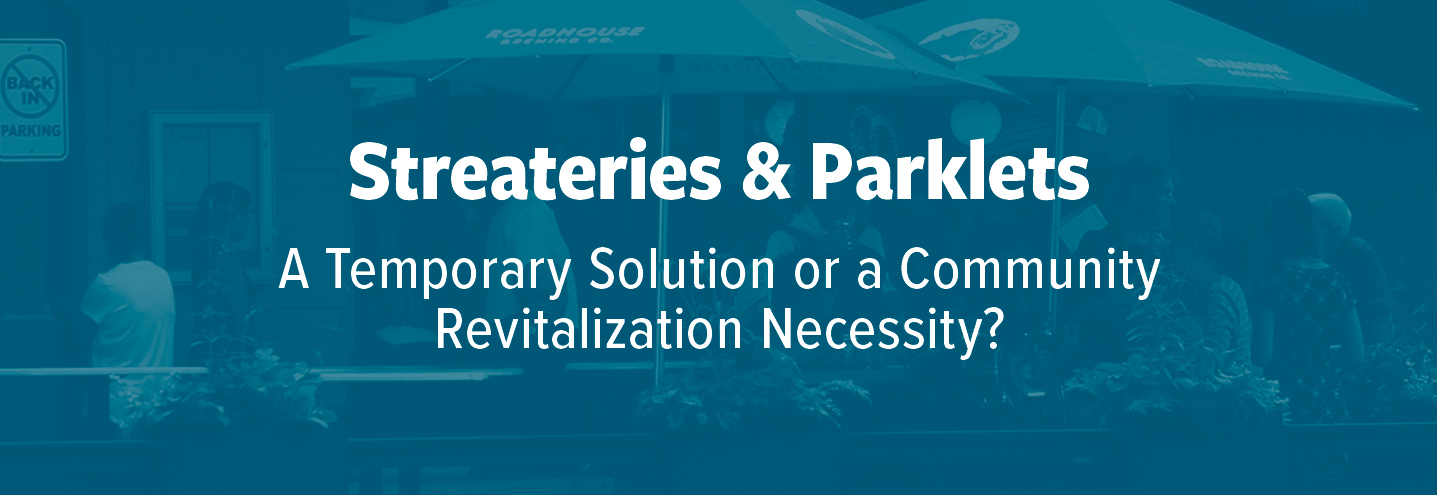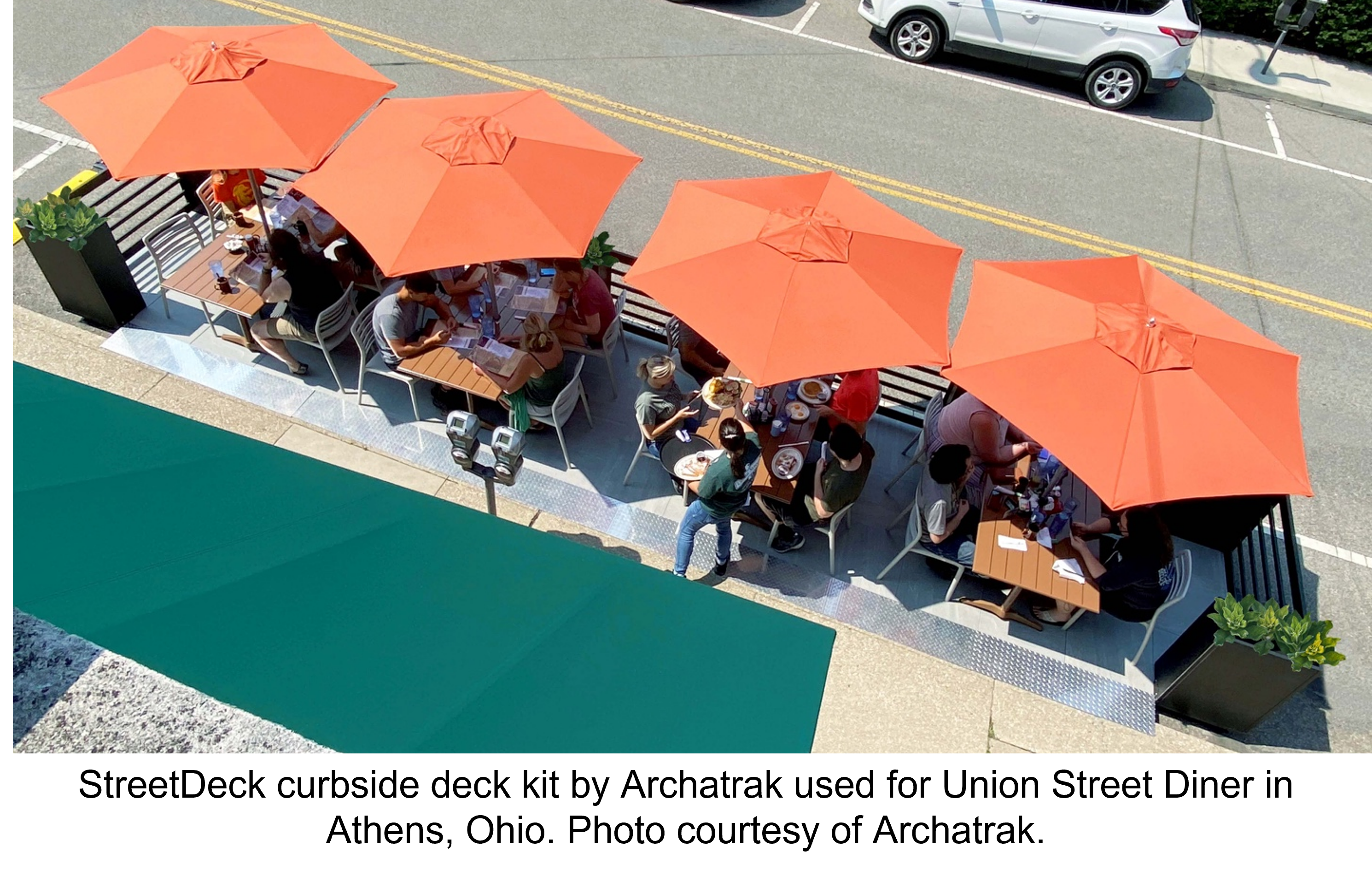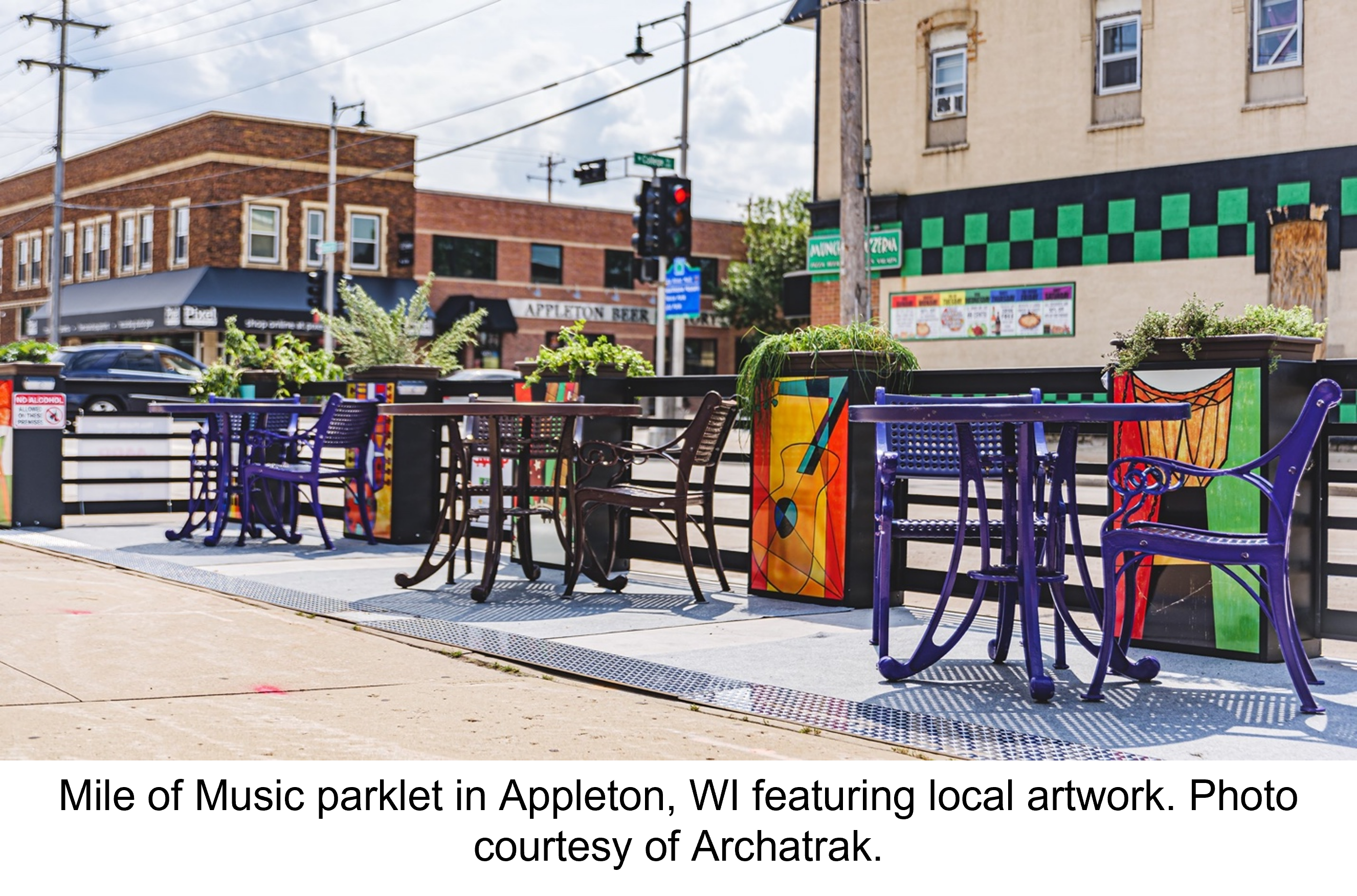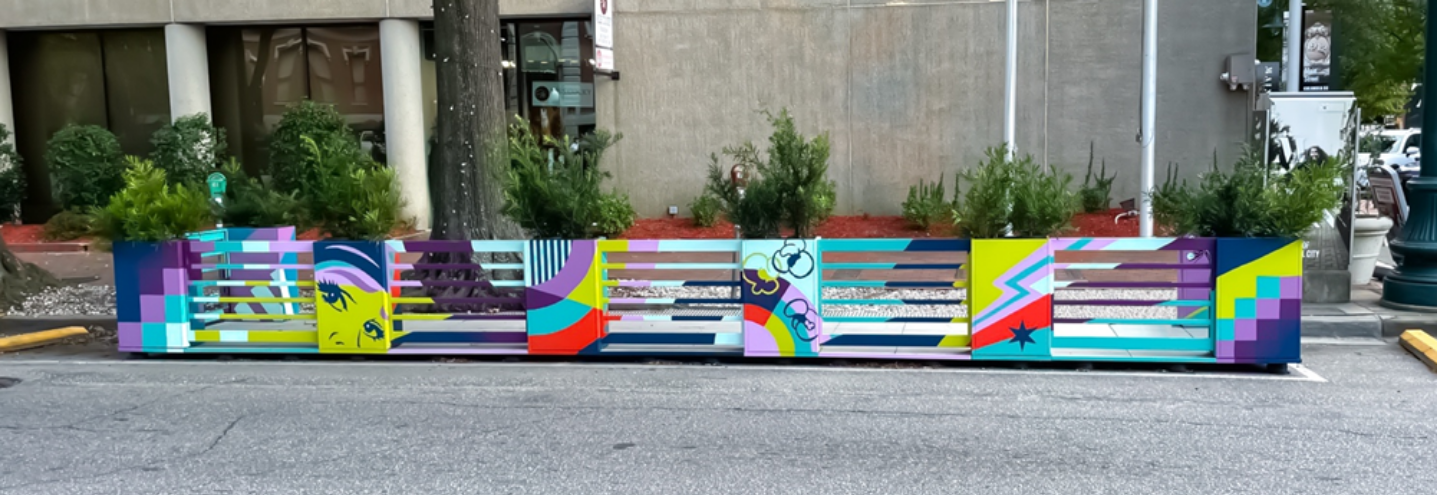Main Spotlight: Connecting, Innovating, and Sustaining a Healthy Main Street Movement
Key takeaways from six sessions at the 2025 Main Street Now Conference.

Back in the spring of 2020, a policy permitting the use of curb-height, sidewalk extension decks for parklets, pedlets and streateries, was seen as little more than a temporary measure to help small local businesses endure the pandemic. Now, these decks have become an integral part of downtown communities throughout the United States.
With many temporary parklet permits due to expire in 2022, city officials and downtown business associations have an opportunity to reevaluate their regulations for these creative outdoor dining and gathering spaces. The time has come to decide what needs to be done from this point forward to help communities of all sizes thrive — economically, socially and health-wise.

Improving downtown walkability: Acting as an extension of nearby stores and restaurants, curbside decks draw in crowds of tourists and local pedestrians that bolster downtown businesses. Take this impact study on the City of Philadelphia for example.
Simplifying social-distancing practices: Curbside decks can provide citizens with the infrastructure they need to effortlessly maintain a safe distance - without even breaking ground. Here are some successful outdoor dining platforms from the American Society of Landscape Architects.
Placing visitors in proximity to local businesses: The visual impact of customers seated outside enjoying a meal with friends and family gives credibility to the restaurants around them. For the same reason a passerby might choose to see a movie based on the size of the line, people choose to visit restaurants with lively outdoor atmospheres.
Taking ownership of public spaces: Parklets offer countless opportunities for collaboration. This parklet in Appleton, WI, for instance, is the result of the combined efforts between a local artist, Appleton Downtown Inc and AARP. Curbside decks have also made room for outdoor music stages, afterschool tutoring sessions for kids, and community workshops across the nation.

Keeping eyes on the street: Parklet impact research suggests that the presence of these decks increased the sense of safety within the neighborhood. The increased volume of pedestrians on the street is likely a contributing factor, especially for women.
Adding bike parking spots and greenery: Plants and bikes have one thing in common: they both have been proven to reduce stress and improve mental and physical health. Installing curbside decks with these amenities can be extremely beneficial to the overall well-being of your community.
A worthwhile ROI: Applying for grants and other means of funding has opened the door for vulnerable businesses to operate in the midst of the ongoing pandemic. Businesses can check with their Downtown Business Associations, City Planning and Economic Development Departments to see what grants may be available for issuing direct support funding.
Whether city planners decide to limit their curbside decks to private-use streateries for a particular restaurant or expand outdoor seating for the public (free of charge), the rules and regulations for these platforms are bound to change over time.
For those interested in transforming existing curbside decks into recognizable community hubs —with equity, sustainability, mobility, and safety in mind— standardizing your city parklet designs with prefabricated modular deck kits could be a step in the right direction.
Cutting out architectural design fees and assuring compliance with the majority of city regulations, parklet kits have seen success in cities and small towns alike from Jackson Hole, WY to Columbia, SC.
Additionally, providing applicants with a list of resources and prefabricated deck options that are compliant with your cities unique needs upfront will help streamline the process and ensure that all future parklets, pedlets, and streateries align with your revitalization goals.

Key takeaways from six sessions at the 2025 Main Street Now Conference.
Learn how Main Streets in Philadelphia are using active transportation to foster healthier and more connected communities.
Thanks to the GM on Main Street grant, Columbia, Tenn. embarked on an ambitious downtown revitalization project to add curb extensions, greenspace, and two informational kiosks to downtown Columbia.

After
Holly, Mich. received funding from the GM on Main Streett grant for their Beautify Holly Battle Alley Social District and Ganshaw Park projects.

After
Chief Innovation Officer Matt Wagner, Ph.D., shares his predictions for the trends impacting Main Streets and small businesses in 2025.
In preparation for the 2025 Main Street Now Conference, Pennsylvania Coordinator Julie Fitzpatrick explores active transportation and public art in Philadelphia.
Music has a unifying power to bring people of all generations, backgrounds, and cultures together for creative expression. Let’s explore how accessible, family-friendly music experiences can strengthen Main Streets across America to build stronger communities, one concert at a time!
Main Street America is pleased to announce the launch of a $1.8 million sub-grant program as part of our partnership with the U.S. Department of Transportation's (USDOT) Thriving Communities Program.

Beloit, Kansas © Shane Hampton
Construction projects can put a lot of stress on your downtown. From preparation to completion, Brooke Prouty at Iowa Economic Development Authority shares best practices to help your Main Street thrive during construction.
Creating real change in business ownership starts with local communities leading the way, backed by strong partnerships and collaborations.
At the heart of thriving Main Streets are vibrant public spaces that unite people of all ages and backgrounds and enrich community life. And what better way to activate public spaces than through the power of free, live music?

Middlesboro, Kentucky © Levitt Foundation
Learn how Main Streets can tap into federal resources to improve transportation infrastructure, take down barriers, and improve access to key services.
Main Street America is proud to announce the release of a new resource to help Main Streets and commercial district organizations better prepare for and respond to more frequent and severe disasters.

Marion, IA © Uptown Marion
This Boston Main Street installed an innovative street mural to highlight crosswalks and improve pedestrian safety.
These seven Main Streets have implemented innovative, exciting, and fun programs to help welcome dogs to their downtowns.
MSA President and CEO Erin Barnes explores how a holiday market in a public park brought a new focus on growing humanitarian needs in downtown city centers.
The RAISE program funds surface transportation projects with local and regional impact by enhancing safety, mobility, sustainability, and economic growth.

Streetscape improvements can make a big difference for Main Streets. © Grant Harper
Learn how Main Street America's work with the DOT's Thriving Communities Program is supporting transformative efforts with community partners like the Shoalwater Bay Indian Tribe.
Apply for federal funding to remove, retrofit, or mitigate transportation infrastructure that creates barriers to community connectivity.
Art is a powerful tool for community change. Learn how the arts can improve community engagement, boost economic development, and connect with the Main Street Approach.
Streets play an important role in our downtown districts. Learn more about Main Street America's recent work with the Department of Transportation to promote vibrant and sustainable downtown roadways.
Learn how the Safe Streets and Roads for All program is providing grants to prevent roadway deaths and serious injuries.

Streetscape in Denison, Texas. © Mel Climer — Climer Design
REV Birmingham and Woodlawn United share how they work to reenergize spaces and places in Birmingham, Alabama, through civic infrastructure projects in the city’s historic commercial corridors.
Learn how this Louisiana town has used an accessibility-first approach to build a welcoming and inclusive community.

Downtown Ruston, Louisiana. Photo by Henry McCoy.
Learn how the Little Five Points neighborhood of Atlanta uses this unique mural program to celebrate Valentine's Day and raise important funding for their work.
Learn how micromobility can increase access, equity, and inclusion in your Main Street with examples from local programs across the network.
This Washington Main Street is encouraging people to brave the rainy weather with their free umbrella share program.
Parking is a challenging problem for many Main Streets. We explored the arguments for and against free parking, and a method for conducting an inventory of parking in your downtown.

Miami, FL © Matt Alaniz
Learn how Bainbridge Island Downtown Association leverages their connection to the ferry to create a walkable and vibrant downtown.

Bainbridge Island, WA © Anna Carson
An innovative artistic project brings new life to the alleyways in Billings, Montana.

Billings, MT © Downtown Billings Alliance
In big cities and small towns, people face increasing danger when navigating communities on foot. As advocates for connected and walkable downtowns, Main Streets have a crucial role to play in increasing pedestrian safety.

Lansing, Michigan © Lansing 5:01
Learn how you can participate in the Thriving Communities program as a capacity builder or how you can receive support from the program.
To celebrate National Parks and Recreation Month, we explored three innovative and interesting parks-based projects and collaborations in Main Street communities.
Waterloo, Iowa, shares advice and lessons learned from their e-scooter program.
Learn how you can harness design principles and strategies to create a cooler, more welcoming downtown.
Main Street America was awarded $5.9 million to support 20 communities in the Main Streets Community of Practice through the Department of Transportation's Thriving Communities Program over the next two years.
The City of Leeds, AL welcomed a new downtown mural over the holidays that has brought a sense of excitement and anticipation for the continuing efforts to focus on the Leeds downtown district.

Leeds, AL © Jeremy Dove
What is more Iowan than turning grain bins into public art? Learn how Main Street Coon Rapids created these beautiful murals to celebrate their downtown.

Coon Rapids, IA © Main Street Coon Rapids
Pollinator gardens are fantastic ways to increase green space, promote sustainability, and educate your community on the local environment.

Crofton, MD © Kerry Kelly
The AARP Community Challenge program gives out quick-action grants to activate public spaces. Meet some of the Main Streets awarded grants through the program this year.
Chairman Emeritus Ed McMahon explores the power of place in creating spaces people love.

Boise, ID © christiannafzger
To support Georgia Main Streets throughout the recovery process and position them for long-term sustainability, Main Street America launched the Georgia Main Street Innovation Grant Program, made possible through generous support from The Williams Family Foundation of Georgia.

Thomasville, GA © Thomasville Main Street
Intentional placemaking has had many unexpected benefits for this Alabama town.

Wetumpka, AL © Jenny Sue Stubbs
We heard from organizations across the nation about the incredible impact their markets have had on community engagement, entrepreneur and small business support, and keeping their district vibrant.
Mount Airy Downtown, Inc., celebrated the return of their Market Street Arts and Entertainment District (MSA & ED) last weekend, as part of their pandemic recovery efforts.

Mount Airy, NC © Robbie Curlee
A vacant storefront is the perfect stage to creatively promote the available space or to showcase other businesses and events in the area.

Ripon, WI © RetailWorks, Inc
Interested in creating a StoryWalk in your downtown commercial district? Read on to learn more about installing a successful story walking trail.
In remembrance and in honor of Dr. Marin Luther King Jr., over 900 streets in the United States were named after him. Many are located predominantly in African American communities.

Milwaukee, WI © Historic King Drive BID
Dubbed the Blues Alley, the Ripley Main Street program plans to install murals of local pioneering Black blues artists, cutout guitars painted by local art students, and blues lyrics painted on the walls.

Ripley, MS © Ripley Main Street
Wayfinding guides people to places they seek but it also brings awareness to places they may have otherwise missed.
Since 2013, Try This West Virginia has sought to improve health environments in local communities as a collaboration of organizations working together to combat the health challenges facing West Virginians.
Main Street America partnered with OneMain Financial to create Made on Main Street.
Creating a historic or art walking tour is much more than simply a collection of pictures and descriptions.
Over 300 attendees enjoyed a family-friendly block party that celebrated the community and showcased Prosser's upcoming streetscape improvement project.
Cambridge was the first Main Street community in Maryland to install public chargers.
The Downtown Newton Development Association (North Carolina) partnered with the City of Newton on a temporary tactical urbanism project to demonstrate how their permanent streetscape improvements will benefit downtown.
Over 500 people braved the misty rain this past weekend to come and celebrate Painesville and its Made on Main Street community transformation project.
Wilson Artsy Alleys is an initiative of the Wilson Downtown Development Corporation which takes the arts to new locations in forgotten places.
In October 2017, Main Street Ottumwa collaborated with local partners, Main Street Iowa, the National Endowment for the Arts, and the Better Block Foundation to stop planning, talking, and wishing, and start doing.
Kelly Tompkins of Main Street Enid shares more about the Maker Trail project and how it inspired creativity and helped people discover downtown.
The Metuchen Downtown Alliance created a cool, family-friendly public gathering space in “the worst looking spot in town” with the help of just $2,500 in Edward Jones Placemaking on Main Challenge matching grant funds,
A collaborative effort launched between Laramie Main Street Alliance (LMSA) and vertical farming company, Plenty, looked to blank downtown walls as a canvas for growing food, creating conversation, and activating overlooked spaces.
From walkability and transportation connectivity, to access to nature and availability of fresh food, place is inextricably linked to achieving positive health outcomes in rural America.
Beautiful view of the Eiffel Tower fountain through Main Street Paris's new Love Lock Fence.
Kasey Drummond, Glenrock Main Street Director, explains how they brought the acclaimed graffiti artist ARCY to their Main Street and explores the work he produced in three additional Wyoming communities on his summer tour.
Karen Dye, Newkirk Main Street's program manager, was inspired to “make downtown more fun and festive” with painted water meter covers after learning about the practice at a recent Main Street Now conference.
Appealing to mobility-challenged shoppers yields benefits beyond the store.
In contrast, the Main Street Program in Laramie, Wyoming, is thriving, having successfully cultivated millions of dollars to help fill these vacant, blighted spaces with permanent structures.
In this article we’ll explore the process of planning, funding, installing, operating, and enjoying music on your Main Street.
In 2016, the North Carolina Main Street & Rural Planning Center partnered with the University of North Carolina at Greensboro’s Department of Interior Architecture (UNCG) to provide design assistance to Main Street communities.
Placemaking is a strategy that Six Corners Association has enthusiastically applied to our community development efforts because of its seamless integration with the Main Street Approach.
How one Wyoming Main Street implemented a free bike share program.
In 2015, the Wisconsin Economic Development Corporation (WEDC) partnered with the University of Wisconsin–Madison to engage Wisconsin Main Street organizations and farmers markets in the Metrics and Indicators for Impact – Farmers Markets (MIFI-FM) toolkit.
The local Main Street organization, Downtown Milford Inc., is trying to address these shifting demographics by creating a more inclusive sense of community.
This is the story of how a National Endowment for the Arts gathering in DC inspired the leaders of a small town in Appalachia to connect with those in Milwaukee to transform a neglected park.
Main Street communities across the country are no stranger to seeking creative strategies to solve their most nagging issues – vacant buildings, marketing downtown, bolstering retail to name a few.
This article is the second in a series on corridors and the important role they play in Main Street revitalization. The previous article focused on the historic origins of corridors, corridor types, and functions that they serve in our communities.
Façade appearance is a critical aspect of the overall aesthetic appeal and unique character of downtown.
While the Main Street program may not take the lead in corridor enhancements, it can be a vital partner and advocate for improvements in overall community appearance.
Street pole banners preserve the historic character of main streets while fostering community awareness and engagement.
With strong community support, the Library Foundation was able to raise over $1.2 million dollars in private donations.
A lot of signs are necessary to make a downtown work well, but not every community knows what a good sign system looks like, or how instrumental it can be to the creation of a successful downtown.
A key goal of the Atlanta Streetcar is to attract investment to and revitalize the neighborhoods along the streetcar alignment.